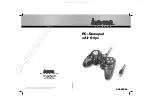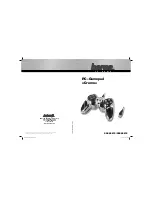
12
100261
ENGLISH
OPERATION
Generator Location
NEVER operate the generator inside any building,
including garages, basements, crawlspaces and sheds,
enclosure or compartment, including the generator
compartment of a recreational vehicle. Please consult
your local authority. In some areas, generators must
be registered with the local utility. Generators used at
construction sites may be subject to additional rules and
regulations. Generators should be on a flat, level surface
at all times (even while not in operation). Generators
must have at least 5 ft. (1.5 m) of clearance from all
combustible material. In addition to clearance from all
combustible material, generators must also have at least
3 ft. (91.4 cm) of clearance on all sides to allow for
adequate cooling, maintenance and servicing. Generators
should never be started or operated in the back of a
SUV, camper, trailer, in the bed of a truck (regular, flat
or otherwise), under staircases/stairwells, next to walls
or buildings, or in any other location that will not allow
for adequate cooling of the generator and/or the muffler.
DO NOT contain generators during operation. Allow
generators to properly cool before transport or storage.
Place the generator in a well-ventilated area. DO NOT
place the generator near vents or intakes where exhaust
fumes could be drawn into occupied or confined spaces.
Carefully consider wind and air currents when positioning
generator.
Failure to follow proper safety precautions may void
manufacturer’s warranty.
Do not operate or store the generator in rain, snow,
or wet weather.
Using a generator or electrical appliance in wet
conditions, such as rain or snow, or near a pool or
sprinkler system, or when your hands are wet, could
result in electrocution.
WARNING
WARNING
During operation the muffler and exhaust fumes
produced will become hot. If adequate cooling and
breathing space are not supplied, or if the generator
is blocked or contained, temperatures can become
extremely heated and may lead to fire.
Grounding
The generator system ground connects the frame to the
ground terminals on the power panel.
– The generator (stator winding) is isolated from the
frame and from the AC receptacle ground pin.
– Electrical devices that require a grounded receptacle
pin connection will not function if the receptacle ground
pin is not functional, unless the neutral wire is bonded
to the frame.
Wireless Remote Start
Wireless remote starting is only possible
within 80 feet
of the generator. (Wireless signal may not pass through
some solid objects.)
Do not attempt to adjust the carburetor choke. The
remote and electric system will automatically close and
open the choke.
1. Make certain the generator is on a flat, level
surface.
2. Turn off all electrical loads connected to the
generator. Never start or stop the generator with
electrical devices turned on.
3. Turn the Fuel Valve to the “ON” position.
4. Press the Battery Switch to “ON”.
5. Press the Ignition Switch to “ON”.
6. WIRELESS REMOTE START: press and release the
“START” button on the handheld Remote Control
device. DO NOT hold the button down, only press
the button once. The engine will attempt to start six
times.
7. If the generator fails to start, check the battery
condition and cable connections.
When the battery switch is in the “ON” position, the
switch will light up if the battery is sending out a
charge. If the switch does not light up while in the “ON”
position, check that the battery connection is still good.
NOTE
The supplied 12V 7AH battery does re-charge while the
engine is running, but it is also recommended that the
battery be fully charged at least once per month.
NOTE
















































